Introduction
George Nelson is known as one of the pioneers of mid-century modern design, an era that embraced functionalism, simplicity, and new materials. Nelson was one of the most innovative and influential designers of the 20th century, and his work continues to inspire designers and artists today. In this article, we will explore the life, career, and design philosophy of George Nelson.
Early Life and Education
George Nelson was born in Hartford, Connecticut in 1908. He attended the Hotchkiss School in Lakeville, Connecticut, and then went on to Yale University, where he studied architecture. During his time at Yale, Nelson was influenced by the work of modernist architects such as Le Corbusier and Walter Gropius, and he began to develop an interest in industrial design.
After graduating from Yale in 1931, Nelson spent a year studying at the American Academy in Rome. He then returned to the United States and began working as an editor at Architectural Forum magazine.
Career in Design
In 1947, George Nelson became the design director of Herman Miller, a furniture company based in Zeeland, Michigan. During his time at Herman Miller, Nelson worked with some of the most talented designers of his generation, including Charles and Ray Eames, Isamu Noguchi, and Alexander Girard.
Nelson was responsible for many of Herman Miller’s most iconic designs, including the Marshmallow Sofa, the Coconut Chair, and the Ball Clock. These designs were characterized by their clean lines, bold colors, and sculptural forms. Nelson’s furniture designs were not only beautiful, but they were also functional and versatile, which made them popular with architects and designers around the world.
The Marshmallow Sofa
One of Nelson’s most famous designs is the Marshmallow Sofa, which was introduced in 1956. The Marshmallow Sofa is made up of 18 circular cushions, which are held together by a metal frame. The sofa was designed to be versatile and comfortable, and it quickly became a favorite of architects and designers.
The Marshmallow Sofa is still in production today, and it has been featured in many films, TV shows, and design exhibitions. It is considered a masterpiece of mid-century modern design.
The Ball Clock
Another iconic design by George Nelson is the Ball Clock, which was introduced in 1949. The Ball Clock is a wall clock made up of 12 colorful balls, each representing an hour. The clock is a playful and whimsical design that perfectly captures the spirit of mid-century modernism.
The Ball Clock has become one of the most recognizable designs of the era, and it is still produced by the Vitra Design Museum today.
Design Philosophy
George Nelson was a designer who believed in the power of design to improve people’s lives. He believed that good design should be accessible, functional, and beautiful. Nelson’s designs were not just about aesthetics, but also about solving problems and making people’s lives better.
Nelson once said, “I have never met a designer who was retained for long by a client who was not happy with his work.” This statement shows that Nelson believed that design was not just about creating beautiful objects, but also about creating solutions that met the needs of the client.
The Importance of Context
One of the most important aspects of George Nelson’s design philosophy was the idea of context. Nelson believed that good design was not just about the object itself, but also about the context in which it was used. He believed that design should be responsive to its environment and the people who used it.
This approach is evident in many of Nelson’s designs, which were created with specific environments in mind. For example, the Coconut Chair was designed to be used in a tropical setting, while the Marshmallow Sofa was designed to be modular and adaptable to many different spaces.
Legacy
George Nelson’s legacy as a designer and thinker has continued to influence the worlds of design, architecture, and art. His work is celebrated for its simplicity, playful wit, and innovative use of materials.
Nelson’s example also continues to inspire designers to embrace the power of design to create objects and environments that are not only beautiful, but also functional and relevant to the needs of the people who use them.
The Power of Good Design
In the end, George Nelson’s work reminds us of the importance of good design in our lives. He believed that design could make the world a better place, and he dedicated his career to making that vision a reality.
Today, as we face the challenges of living in a rapidly changing world, Nelson’s example reminds us of the power of design to shape our environments and our experiences. His legacy as a visionary designer and thinker will continue to inspire future generations to create objects and environments that are functional, beautiful, and meaningful.



